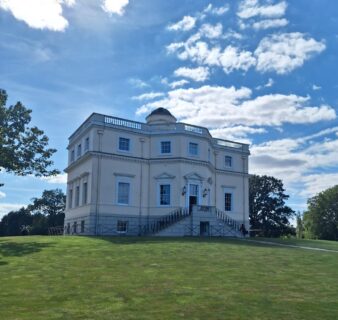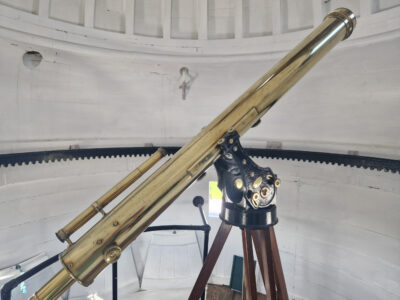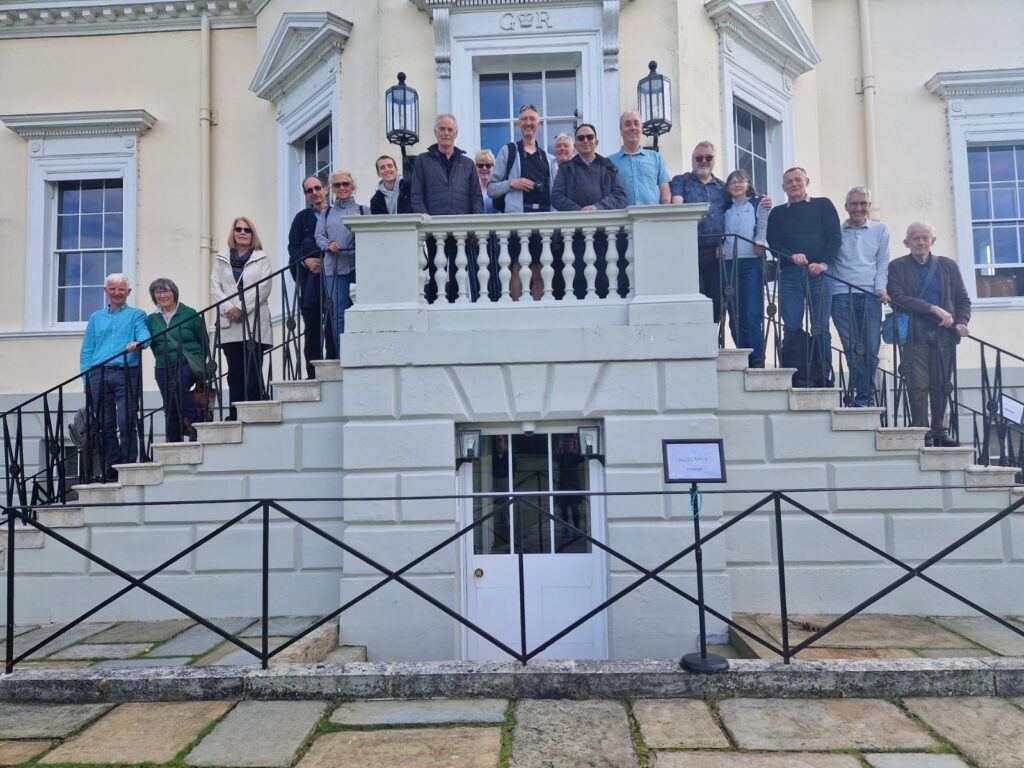It was a lovely warm September morning and the Sun was shining as 20 of us began our journey across London to Richmond for our trip to the Kings Observatory.
We arrived in Richmond with plenty of time to wander around and have some lunch, before making our way to the Kings Observatory which was a short 20 minute walk across the ‘Old Deer Park’ – although there were no Deer to be seen. However, at one point we had to walk down a narrow road that ran straight through the middle of a Golf course, so it was eyes peeled to ensure no stray Golf Balls were hurtling towards us.
We all arrived safely at the Kings Observatory a little early, our guides were ready so the tours commenced.
 The King’s Observatory, located in Richmond, London, is a historically significant site renowned for its contributions to astronomy and its architectural heritage. The observatory represents a pivotal moment in scientific history and has since evolved into a notable cultural landmark. It was commissioned by King George III in 1769, primarily to observe the transit of Venus across the sun, an event of considerable scientific importance for the time.
The King’s Observatory, located in Richmond, London, is a historically significant site renowned for its contributions to astronomy and its architectural heritage. The observatory represents a pivotal moment in scientific history and has since evolved into a notable cultural landmark. It was commissioned by King George III in 1769, primarily to observe the transit of Venus across the sun, an event of considerable scientific importance for the time.
The observatory’s creation was driven by the need to improve the accuracy of astronomical observations and to support the king’s interest in science. It was designed by architect Sir William Chambers, renowned for his neoclassical style, and built on a site selected for its advantageous position and clear skies.
During its operational peak, the King’s Observatory made significant contributions to the field of astronomy. The observations made here helped refine the measurement of astronomical distances and facilitated a better understanding of celestial phenomena. The data collected during the transit of Venus, for instance, was crucial for calculating the astronomical unit, the average distance between the Earth and the Sun.
The observatory was also involved in the development of more accurate timekeeping methods, which were essential for navigation and scientific research. The work conducted here laid the groundwork for future astronomical advancements and improved the precision of celestial observations.
The observatory’s Cupola is particularly noteworthy. It was constructed to house a large astronomical telescope, which was one of the most advanced instruments of its time.
 The Cupola design was the first of its kind to be constructed in Britain and incorporated on the top of a large building, the design was inspired by a similar Cupola in Sweden which was used by the Swedish astronomer, physicist and mathematician – Anders Celsius (who of course has the modern day temperature scale named after him).
The Cupola design was the first of its kind to be constructed in Britain and incorporated on the top of a large building, the design was inspired by a similar Cupola in Sweden which was used by the Swedish astronomer, physicist and mathematician – Anders Celsius (who of course has the modern day temperature scale named after him).
We were all so impressed with the Cupola area and telescope and to know we were standing in the same spot as King George III did to observe the transit of Venus all those years ago was incredible.
The main building has been gradually renovated and restored over the past few years, the rooms and areas that we toured are very impressive, one of those rooms is an astronomical library, which historically contained valuable texts and instruments that supported its scientific mission.
At one time there were over 65,000 books in the library, the number of books has been reduced but there are still thousands and most there now had been donated by the actor Sir Alec Guinness (lead role in the Film – Bridge on the River Kwai) and the actor Benjamin Whitrow (who played Mr Bennet in the BBC TV series – Pride and Prejudice).
Some other notable facts are:
From 1910 to 1980, the then named Kew Observatory was the home of the Meteorological Office and was from where weather reports went out to the Country. Then later of course the Meteorological Office relocated to Bracknell in Berkshire.
Three obelisks erected in June 1778 within the Old Deer Park assisted in aligning instruments at the Observatory. The northern and western obelisks marked the true north-south Meridian Line, passing through the west room housing a tracking telescope. The southern obelisk aligned with the east room, which once held the great mural quadrant. So, in fact the Prime Meridian (prior to Greenwich) was located at King George III, Kew (later Richmond) Observatory until it moved to Greenwich in 1884.
The building itself is surrounded by some beautiful grounds with a small lake and a boat house.
Although its scientific role has evolved, the site continues to be a valuable cultural and educational resource. Its preservation ensures that future generations can appreciate both its historical significance and its contributions to the advancement of Astronomy and Science.
 The King’s Observatory lived up to all expectations and we all had an interesting and enjoyable day – as the day went on it seemed to get warmer with continuous bright Sunshine, so we were relived to finally get home feeling a bit tired but knowing we had a lovely visit and experience.
The King’s Observatory lived up to all expectations and we all had an interesting and enjoyable day – as the day went on it seemed to get warmer with continuous bright Sunshine, so we were relived to finally get home feeling a bit tired but knowing we had a lovely visit and experience.
Article prepared by Dave Allen – September 2024

